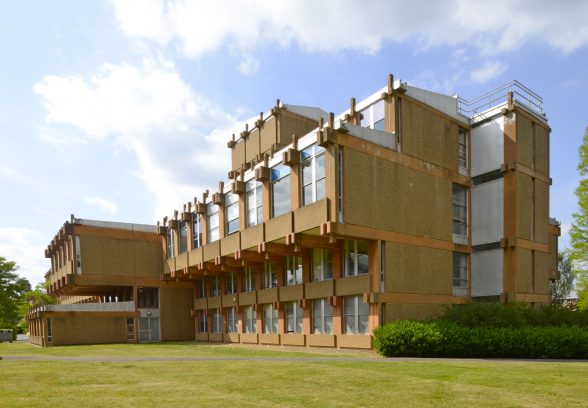This website uses cookies
This website uses cookies to enable it to function properly and to analyse how the website is used. Please click 'Close' to accept and continue using the website.



College of Estate Management by HKPA
The Twentieth Century Society is delighted to announce the Grade II listing of the College of Estate Management on Whiteknights Campus at the University of Reading, also known as the “Lego Building.”
The Society submitted an application for listing following the appointment of architects Hawkins/Brown to carry out a major two-year refurbishment programme along with a request for a Certificate of Immunity, which would have prevented the building from being designated for five years.
Catherine Croft, C20 Society Director, said: ‘With its strong silhouette and distinctive form, this is an important building by one of the foremost British architectural practices of the post-war period and we are delighted this has been recognized with listing at Grade II. We acknowledge that some modernization needs to be made but we want to ensure that any alterations are conservation led and in keeping with the integrity of the original design.”
In its listing decision, Historic England says that while the overall planning of the building forms part of its special interest, the cellular division of rooms to either side of the central spine, does not. For this reason it has been decided that the non-structural party walls between adjacent rooms are excluded from the listing.
The College of Estate Management (1970-3) was designed by Howell, Killick, Partridge & Amis to house the College following its incorporation into the University of Reading. Pevsner notes approvingly that architecture at the University at this time ‘reached a climax’ with this ‘linear megastructure that is at once rigorous and extravagant in its deployment of closely spaced concrete framing’.
Constructed as a major new teaching building of four and five storeys, the building houses two lecture theatres, tutorial, studio and conference rooms, and a range of other teaching spaces and offices. The space is fragmented into groups of rooms of differing lengths, heights and depths, creating a constantly changing cross-section of variable steps. The central corridor, part of the generous circulation spaces, runs the length of the building and gives the impression that the building is endlessly extendable. On the north side, the open ground floor is sheltered by the overhanging floor above, creating a colonnaded undercroft from which the bones of the structure can be admired.
The structure consists of a series of reinforced concrete frames. The major frames are placed in pairs at regular intervals, with the beam-ends projecting both horizontally and vertically and with uprights clasped between. These projecting ‘ears’, with echoes of Japanese timber construction, give the building its distinctive rugged appearance.
The post-war expansion of higher education was one of the greatest achievements of the period, with universities growing greatly in number and in size. While university building of the 1950s got off to an unadventurous start, the turn towards Modernism swiftly followed, and from the late part of the decade onwards, universities became the country’s most ambitious architectural patrons. Some of the resultant buildings have come to be regarded as the best works of the period’s most eminent architects, and a number are listed.
The College of Estate Management Building is one of the last major university works by HKPA. William Howell (1922-74), John Killick (1924-71), John Partridge (1924–) and Stanley Amis (1924–) met in 1950 at the architect’s department of the London County Council, where they designed the acclaimed Roehampton Lane estate (now known as Alton West, parts of which are listed at Grade II and II*). Several private commissions and competition entries – notably their second-placed entry of 1959 for Churchill College, Cambridge – launched them into practice.
HKPA went on to develop a new architectural idiom for the expanding higher education sector. At Cambridge, Howell designed the University Centre (listed Grade II), and new buildings for Downing, Darwin and Sidney Sussex Colleges. At Oxford, their Wolfson and Rayne Buildings for St Anne’s College and the Hilda Besse Building at St Antony’s College (all listed at Grade II) were overseen by John Partridge. In addition the firm designed Acland Burghley School for the London County Council (Grade II), the Ashley and Strathcona Buildings at Birmingham University (both Grade II) and the Mathematicians’ Houses at Warwick University (Grade II*).
Other HKPA examples include the curved Strathcona Building at Birmingham University, 1961-64, listed Grade II, and their Wolfson and Rayne buildings at St Anne’s College, Oxford, 1960-69, listed Grade II. The idea at Reading of loading a central spine with accommodation that projects out and cuts in to either side, creating a linear plan of dynamic cross section, coupled with natural light brought into the centre of the building, is novel in HKPA’s oeuvre.
In its listing decision, HE says it would be unfair to compare this building with HKPA’s more generously funded Oxbridge work; at Reading a limited budget has been made to work hard. The building is rigorous and functional, without pretension or grand gesture, and the very low level of alteration is testament to its qualities. It stands comfortably alongside the best post-war university buildings and is therefore recommended for listing at Grade II. The application for a Certificate of Immunity was refused.

Become a C20 member today and help save our modern design heritage.